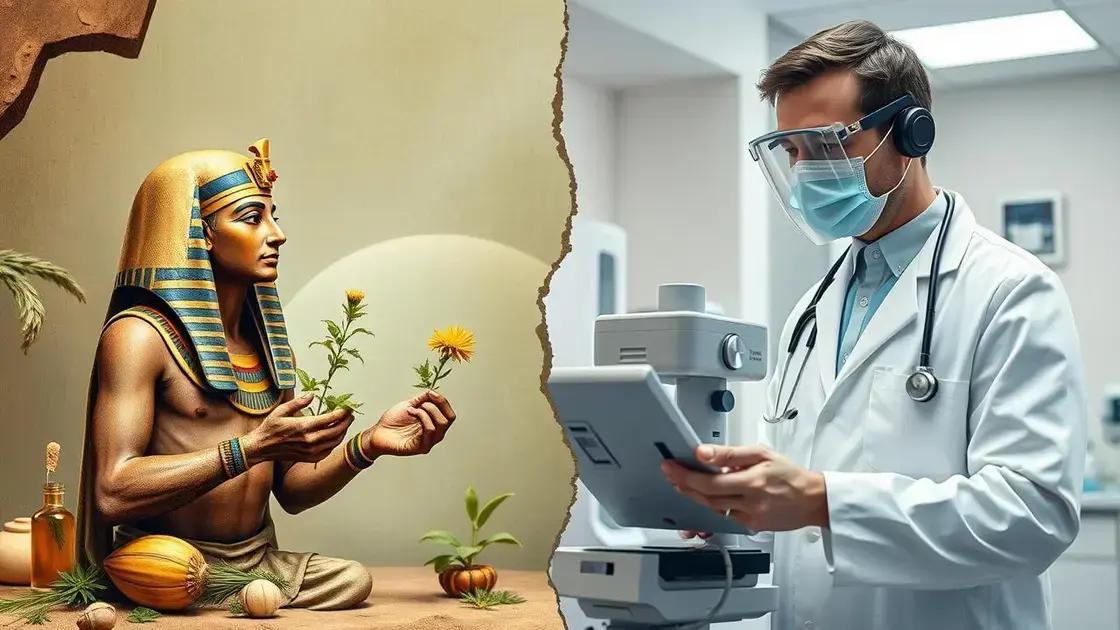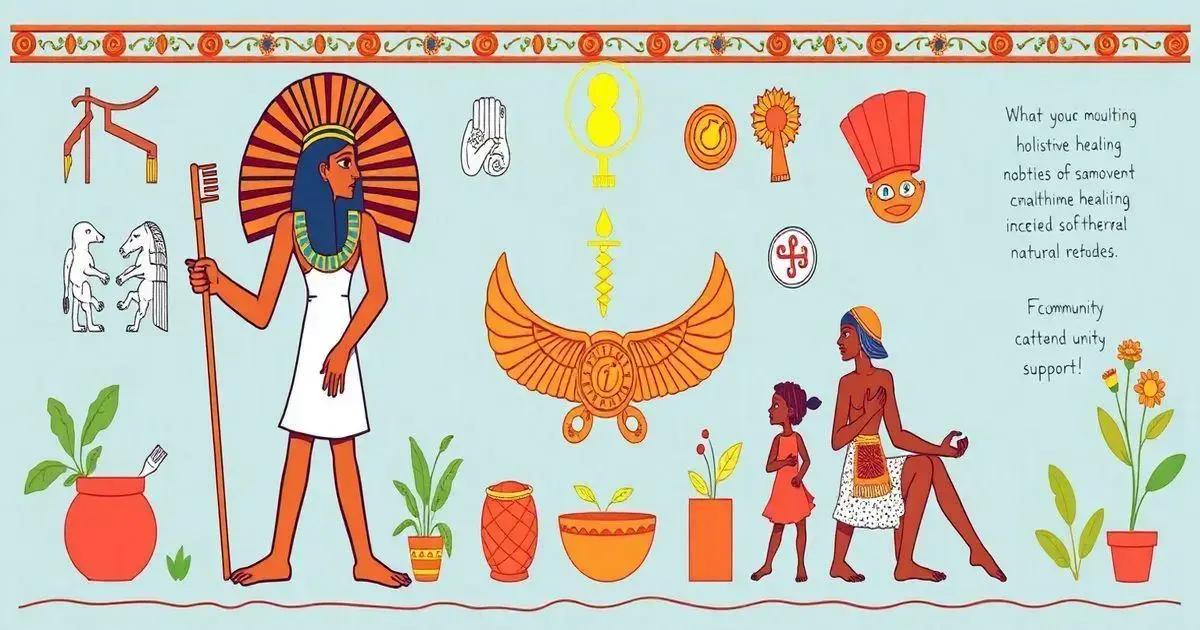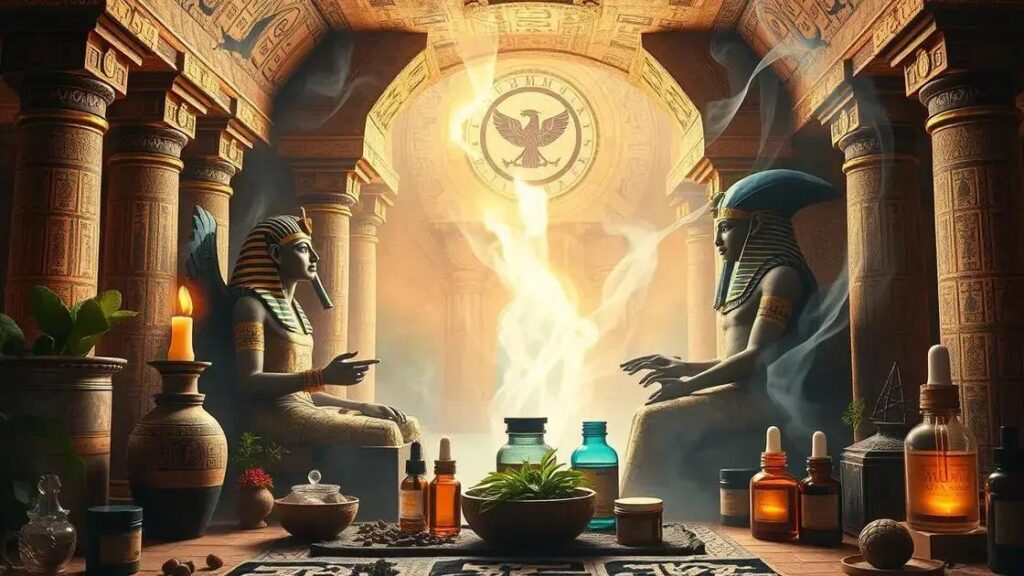The comparison between the tricks of the Egyptian Pharaohs and modern remedies reveals how ancient practices, including holistic approaches and natural remedies, have influenced today’s healthcare system, emphasizing the importance of integrating historical knowledge with contemporary scientific advancements.
The fascinating comparison between the tricks of the Egyptian Pharaohs and modern remedies unveils a world where ancient wisdom meets contemporary health solutions. This exploration provides insights into healing practices that have emerged from times long past, revealing how these ancient methods still echo in today’s remedies. Join us as we delve into the unique techniques employed by Pharaohs and how they compare against modern medical practices. Discover the rich history behind these practices and their relevance in our quest for health and well-being.
Ancient Egyptian Tricks: An Overview

Ancient Egyptians were known for their remarkable tricks and methods to improve health and well-being. Among these tricks were a blend of natural remedies, spiritual rituals, and advanced knowledge of anatomy.
Natural Remedies
The Egyptians utilized a variety of herbs and plants for medicinal purposes. Common plants included coriander, fenugreek, and garlic. These were often used to treat ailments ranging from digestive issues to infections.
Spiritual and Ritualistic Practices
Health was not only a physical concern but also a spiritual one. Many Egyptians engaged in rituals and prayers to invoke healing from the gods. They believed that illnesses could be the result of displeasing a deity. Thus, they sought to restore harmony through religious ceremonies.
Understanding of Anatomy
Another remarkable aspect of their practice was their understanding of the human body. The Egyptians practiced embalming, which gave them insights into human anatomy and led to a better understanding of ailments and their treatments. This knowledge allowed them to perform surgeries and treat injuries much more effectively.
Documented Knowledge
Medical texts, like the Ebers Papyrus, documented various treatments and spells. These texts served as a guide for physicians of the time, indicating the advanced state of their medical knowledge.
Through these fascinating tricks, Ancient Egyptians paved the way for many modern remedies. Their holistic approach combined physical treatment with spiritual beliefs, showing that health encompasses both body and spirit.
How Modern Remedies Evolved

Modern remedies have evolved significantly from ancient practices. Throughout history, our understanding of health and treatments has expanded due to advancements in science, technology, and research.
Scientific Breakthroughs
The introduction of the scientific method in the 17th century marked a turning point for medicine. Researchers began to rely on experimentation and observation rather than solely on tradition. This shift led to many discoveries in cell biology, microbiology, and pharmacology.
Development of Pharmaceuticals
Pharmaceutical companies began to emerge, developing medications that target specific ailments. Over time, we saw the creation of antibiotics, pain relievers, and vaccines. These modern medicines provide stronger and more effective treatments compared to ancient remedies.
Integration of Technology
Today, technology plays a key role in medicine. From telemedicine to wearable health devices, patients can access healthcare like never before. Digital tools allow for better monitoring of conditions and personalized treatment plans.
Holistic Approaches and Natural Remedies
Despite modern advancements, there is a growing interest in holistic and natural remedies. People are blending traditional practices with modern science, focusing on overall wellness. This blend often includes nutritional guidance, mindfulness, and herbal treatments as complementary methods.
Overall, the evolution of modern remedies reflects human innovation and adaptability. As we learn and grow, our understanding of health continues to transform, creating new pathways for healing.
Comparative Analysis of Healing Techniques

A comparative analysis of healing techniques reveals how ancient and modern practices differ yet share some common goals. Both aim to restore health and improve quality of life.
Holistic vs. Conventional Approaches
Ancient Egyptian healing techniques were often holistic. They integrated physical, mental, and spiritual health. In contrast, modern medicine frequently focuses on specific symptoms or diseases using targeted treatments.
Techniques Used in Ancient Egypt
Ancient Egyptians employed a combination of herbal medicines, rituals, and surgery. Doctors known as ”swnw” had knowledge about anatomy, which they gained from mummification practices. They would use salves, poultices, and spells to treat ailments.
Modern Techniques and Innovations
Today’s healing practices use evidence-based methods. Physicians rely on advanced technology and pharmaceuticals to treat illnesses. Techniques can include radiation therapy, chemotherapy, and surgeries that utilize robotic assistance.
The Importance of Patient-Centered Care
Both ancient and modern practices emphasize the importance of patient-centered care. Egyptians believed in the involvement of the family in healing, while modern practices push for shared decision-making, ensuring that patients are active participants in their treatment plans.
By analyzing these techniques, we see that while approaches may vary, the core objective remains the same: achieving optimal health through suitable methods for the time.
Lessons From Pharaohs for Today’s Healing

There are valuable lessons we can learn from the ancient Egyptian healing practices that can be applied to today’s healthcare. These insights highlight the significance of a holistic approach and the integration of various healing techniques.
The Role of Natural Remedies
Ancient Egyptians often relied on natural remedies derived from plants. Today, there is a growing movement towards natural and herbal remedies in modern medicine. Recognizing the benefits of nature can help promote healthier lifestyles and treatment options.
Importance of Rituals and Mindfulness
Rituals were essential in Egyptian healing practices, connecting physical and spiritual health. Today, incorporating mindfulness and meditative practices can enhance mental health and stress relief for patients. These practices are proving important for overall wellness.
Community and Family Involvement
Pharaohs acknowledged the importance of community support in healing. Family members often played a role in the care of the sick. Today, fostering a similar sense of community involvement in healthcare can improve patient outcomes and emotional well-being.
Combining Knowledge Across Practices
The blending of ancient techniques with modern treatments can enrich healing. For instance, integrating traditional Chinese medicine with Western pharmacology offers a broader perspective on health. Learning from past practices allows for a more comprehensive approach to modern healthcare.
By examining these lessons from the Pharaohs, we understand that health is not only about treating symptoms but also about nurturing the entire being—physically, mentally, and spiritually.
Bridging the Past and Present in Healing
The exploration of healing techniques from the time of the Egyptian Pharaohs to modern remedies highlights the evolution of health practices. By merging ancient wisdom with contemporary science, we can enhance our understanding of wellness.
Lessons from the Pharaohs teach us the significance of holistic approaches, community involvement, and the benefits of natural remedies. This fusion can lead to a more comprehensive healthcare system that addresses both physical and mental health.
As we move forward, embracing these insights can unlock new methods of healing and improve patient care. The journey of healing is enriched by recognizing the value of historical practices while innovating for the future.
In conclusion, a united approach to healing, blending old and new, can pave the way for better health outcomes for all.
FAQ – Frequently Asked Questions about Healing Techniques
What were the main healing practices of the Egyptian Pharaohs?
The Egyptian Pharaohs used a mix of natural remedies, spiritual rituals, and advanced anatomical knowledge to treat various ailments.
How have modern remedies evolved from ancient practices?
Modern remedies have evolved through scientific advancements, leading to the development of targeted pharmaceuticals and technology-based healthcare solutions.
What holistic approaches are found in both ancient and modern healing?
Both ancient Egyptians and modern medicine emphasize the importance of treating the whole person, focusing on physical, mental, and spiritual health.
How can community involvement impact healthcare?
Community involvement in healthcare can improve patient outcomes and emotional well-being by providing support and a sense of belonging during treatment.
What natural remedies have been rediscovered in modern health?
Many natural remedies, such as herbal treatments, have seen a resurgence in popularity as people seek alternative and complementary therapies.
Why is it important to integrate ancient techniques with modern medicine?
Integrating ancient techniques with modern medicine can offer a more holistic approach to health, enhancing treatment outcomes and increasing patient satisfaction.












